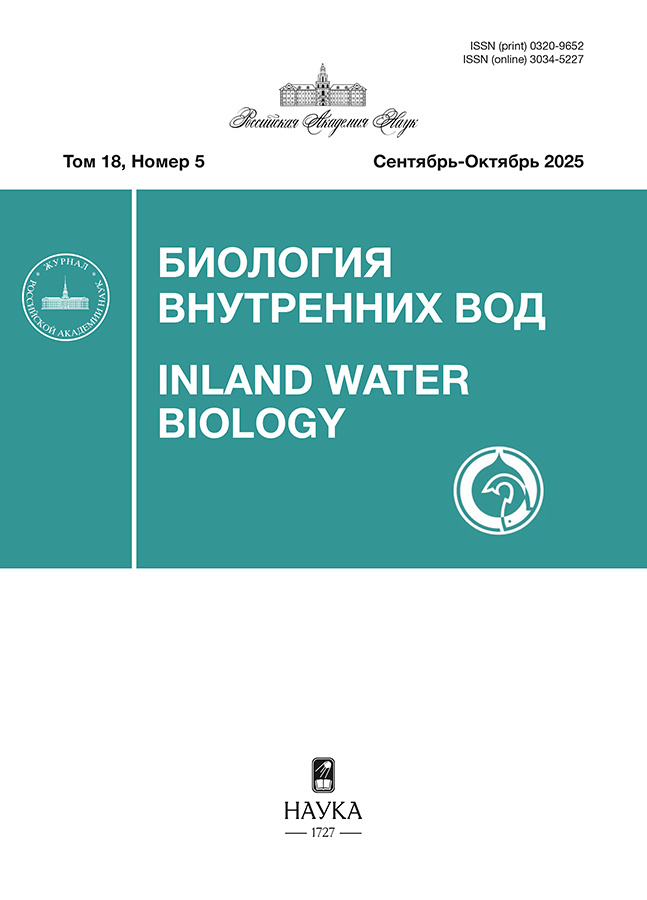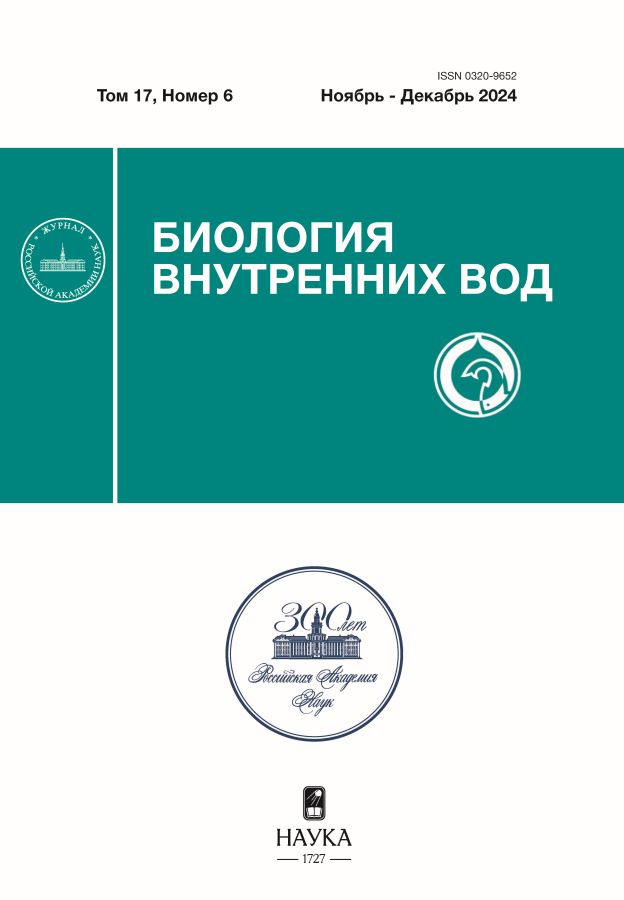Первые данные о цианотоксинах и генах их биосинтеза в фитопланктоне мезотрофного оз . Плещеево (Россия) в период цветения воды цианобактерией Gloeotrichia echinulata
- Авторы: Сиделев С.И.1,2, Корнева Л.Г.2, Чернова Е.Н.3, Сахарова Е.Г.2
-
Учреждения:
- Ярославский государственный университет им. П.Г. Демидова
- Институт биологии внутренних вод им. И.Д. Папанина Российской академии наук
- Санкт-Петербургский Федеральный исследовательский центр Российской академии наук, Санкт-Петербургский научно-исследовательский центр экологической безопасности Российской академии наук
- Выпуск: Том 17, № 6 (2024)
- Страницы: 1016-1026
- Раздел: ВОДНАЯ ТОКСИКОЛОГИЯ
- URL: https://rjonco.com/0320-9652/article/view/670033
- DOI: https://doi.org/10.31857/S0320965224060145
- EDN: https://elibrary.ru/WWUNBI
- ID: 670033
Цитировать
Полный текст
Аннотация
Впервые приведены данные о цианобактериальных токсинах и генах их биосинтеза в фитопланктоне мезотрофного оз. Плещеево (Ярославская обл.) в период “цветения” воды цианобактерией Gloeotrichia echinulata (Smith et Sowebry) Richter. В фитопланктоне озера методом хромато-масс-спектрометрии обнаружено присутствие гепатотоксинов микроцистинов, а в ДНК, выделенной из планктона, методом ПЦР детектирован ген mcyE биосинтеза этих цианотоксинов. В период проведения исследования других типов цианотоксинов (цилиндроспермопсин, анатоксин-а, сакситоксины) и наличия генов их синтеза в фитопланктоне не идентифицировано. В 30 колониях G. echinulata , изолированных из озера, гены mcyA и mcyE биосинтеза микроцистинов отсутствовали, что согласуется с их неспособностью к продуцированию цианотоксина. Показана потенциальная способность к биосинтезу микроцистинов цианобактерии Microcystis aeruginosa и видов рода Dolichospermum , обитающих в озере, с использованием молекулярных методов. Обсуждаются вопросы токсичности Gloeotrichia echinulata и необходимость дальнейшего долгосрочного мониторинга токсигенных цианобактерий в оз. Плещеево.
Ключевые слова
Полный текст
Об авторах
С. И. Сиделев
Ярославский государственный университет им. П.Г. Демидова; Институт биологии внутренних вод им. И.Д. Папанина Российской академии наук
Автор, ответственный за переписку.
Email: Sidelev@mail.ru
Россия, Ярославль; пос. Борок, Некоузский р-н, Ярославская обл.
Л. Г. Корнева
Институт биологии внутренних вод им. И.Д. Папанина Российской академии наук
Email: Sidelev@mail.ru
Россия, пос. Борок, Некоузский р-н, Ярославская обл.
Е. Н. Чернова
Санкт-Петербургский Федеральный исследовательский центр Российской академии наук, Санкт-Петербургский научно-исследовательский центр экологической безопасности Российской академии наук
Email: Sidelev@mail.ru
Россия, Санкт-Петербург
Е. Г. Сахарова
Институт биологии внутренних вод им. И.Д. Папанина Российской академии наук
Email: Sidelev@mail.ru
Россия, пос. Борок, Некоузский р-н, Ярославская обл.
Список литературы
- Александров С.В., Смирнова М.М. 2023. Влияние “цветения” воды на прибрежную зону Куршского залива Балтийского моря // Биология внутр. вод. № 6. C. 801. https://doi.org/ 10.31857/S0320965223060037
- Горюнова С.В., Демина Н.С. 1974. Водоросли – продуценты токсических веществ. М.: Наука.
- Зайцева Т.Б., Медведева Н.Г. 2022. Влияние биогенных элементов на рост нитчатых цианобактерий – возбудителей “цветения” воды и синтез ими метаболитов // Биология внутр. вод. № 3. C. 290. https://doi.org/ 10.31857/S0320965222030196
- Кондратьева Н.В., Коваленко О.В. 1975. Краткий определитель видов токсических синезеленых водорослей. Киев: Наук. думка.
- Копылов А.И., Косолапов Д.Б. 2007. Микробиологические индикаторы эвтрофирования пресных водоeмов // Сб. матер. междунар. конф. “Биоиндикация в мониторинге пресноводных экосистем”. СПб.: ЛЕМА. С. 176.
- Костина Т.Б. 1992. Фитопланктона озера Плещеево в 1990 г. // Факторы и процессы эвтрофикации озера Плещеево. Ярославль: Яросл. гос. ун-т. С. 28.
- Кузьмин Г.В. 1975. Фитопланктон. Видовой состав и обилие // Методика изучения биогеоценозов внутренних водоемов. M.: Наука. C. 73.
- Рохмистров В.Л. 1992. Физико-географические особенности бассейна озера Плещеево // Факторы и процессы эвтрофикации озера Плещеево. Ярославль: Ярослав. гос. ун-т. С. 5.
- Сахарова Е.Г. 2019. Фитопланктон озера Плещеево в 2014–2016 гг. // Тр. Ин-та биологии внутр. вод им. И.Д. Папанина РАН. Вып. 86(89). С. 23.
- Сиделев С.И., Бабаназарова О.В. 2020. Обнаружение цианобактериальных токсинов в источниках водоснабжения и водопроводной воде некоторых городов России: поиск продуцентов и апробация методов удаления // Водн. ресурсы. Т. 47. № 2. С. 218.
- Чернова Е.Н., Русских Я.В., Подольская Е.П. и др. 2016. Определение микроцистинов и анатоксина-а методом жидкостной хромато-масс-спектрометрии низкого разрешения // Научное приборостроение. Т. 26. № 1. С. 11.
- Экосистема озера Плещеево. 1989. Л.: Наука.
- Ballot A., Fastner J., Wiedner C. 2010. Paralytic shellfish poisoning toxin-producing cyanobacterium Aphanizomenon gracile in Northeast Germany // Appl. and Environ. Microbiol. V. 76. P. 1173. https://doi.org/ 10.1128/AEM.02285-09
- Baron-Sola A., Ouahid Y., Campo F. 2012. Detection of potentially producing cylindrospermopsin and microcystin strains in mixed populations of cyanobacteria by simultaneous amplification of cylindrospermopsin and microcystin gene regions // Ecotoxicol. and Environ. Saf. V. 75. P. 102. h ttps://doi.org/10.1016/j.ecoenv.2011.08.022
- Carey C.C., Rengefors K. 2010. The cyanobacterium Gloeotrichia echinulata stimulates the growth of other phytoplankton // J. Plankton Res. V. 32. P. 1349. https://doi.org/10.1093/plankt/fbq046
- Carey C.C., Haney J.F., Cottingham K.L. 2007 . First report of microcystin-LR in the cyanobacterium Gloeotrichia echinulata // Environ. Toxicol. V. 22. № 3. P. 337. https://doi.org/10.1002/tox.20245
- Carey C.C., Ewing H.A., Cottingham K.L. et al. 2012. Occurrence and toxicity of the cyanobacterium Gloeotrichia echinulata in low-nutrient lakes in the northeastern United States // Aquat. Ecol. V. 46. № 4. P. 395. https://doi.org/10.1007/s10452-012-9409-9
- Chernova E., Russkikh Ia., Voyakina E. et al. 2016. Occurrence of microcystins and anatoxin-a in eutrophic lakes of Saint-Petersburg, Northwestern Russia // Oceanol. and Hydrobiol. Stud. V. 45. № 4. P. 466. h ttps://dx.doi.org/10.1515/ohs-2016-0040
- Chernova E., Sidelev S., Russkikh I. et al. 2017. Dolichospermum and Aphanizomenon as neurotoxins producers in some Russian freshwaters // Toxicon. V. 130. P. 47. https://doi.org/10.1016/j.toxicon.2017.02.016
- Chorus I., Welker M. 2021. Toxic cyanobacteria in water. London: CRC Press. https://doi.org/10.1201/9781003081449
- Codd G.A., Bell S.G., Brooks W.P. 1989. Cyanobacterial toxins in water // Water Sci. and Technol. V. 21. № 3. P. 1. https://doi.org/10.2166/wst.1989.0071
- Cronberg G., Annadotter H., Lawton L.A. 1999. The occurrence of toxic blue-green algae in Lake Ringsjön, southern Sweden, despite nutrient reduction and fish biomanipulation // Hydrobiologia. V. 404. P. 123. https://doi.org/10.1023/A:1003780731471
- Ernst B., Hoeger S.J., O’Brien E. et al. 2009. Abundance and toxicity of Planktothrix rubescens in the pre-alpine Lake Ammersee, Germany // Harmful Algae. V. 8. № 2. P. 329. https://doi.org/10.1016/j.hal.2008.07.006
- Gorham P.R. 1962. Laboratory studies on the toxins produced by waterblooms of blue‒green algae // Amer. J. Public Health. V. 52. № 12. P. 2100. https://doi.org/ 10.2105/ajph.52.12.2100
- Gorham P.R. 1964. Toxic algae // Algae and Man. N.Y.: Plenum Press. P. 307. https://doi.org/10.1007/978-1-4684-1719-7
- Gugger M., Molica R., Le Berre B. et al. 2005. Genetic diversity of Cylindrospermopsis strains (cyanobacteria) isolated from four continents // Appl. and Environ. Microbiol. V. 71. № 2. P. 1097. https://doi.org/10.1128/AEM.71.2.1097-1100.2005
- Halme M., Rapinoja M.-L., Karjalainen M. et al. 2012. Verification and quantification of saxitoxin from algal samples using fast and validated hydrophilic interaction liquid chromatography–tandem mass spectrometry method // J. Chromatography B. V. 880. P. 50. h ttp://dx.doi.org/10.1016/j.jchromb.2011.11.015
- Hisbergues M., Christiansen G., Rouhiainen L. et al. 2003. PCR-based identification of microcystin-producing genotypes of different cyanobacterial genera // Arch. Microbiol. V. 180. P. 402. https://doi.org/10.1007/s00203-003-0605-9
- Huisman J., Codd G.A., Paerl H.W. et al. 2018. Cyanobacterial blooms // Nat. Rev. Microbiol. V. 16. № 8. P. 471. https://doi.org/10.1038/s41579-018-0040-1
- Ingram W.M., Prescott G.W. 1954. Toxic freshwater algae // American Midland Naturalist. V. 52. № 1. P. 75. https://doi.org/10.2307/2422044
- Jungblut A.D., Neilan B.A. 2006. Molecular identification and evolution of the cyclic peptide hepatotoxins, microcystin and nodularin, synthetase genes in three orders of cyanobacteria // Arch. Microbiol. V. 185. P. 107. https://doi.org/10.1007/s00203-005-0073-5
- Kappers F.I., Leeuwangh P., Dekker M. et al. 1981. Investigation of the presence of toxins produced by cyanobacteria (blue‒green algae) in the Netherlands // Sci. Total Environ. V. 18. P. 359. h ttps://doi.org/10.1016/S0048-9697(81)80072-1
- Kurmayer R. 2017. Isolation of single cyanobacteria colonies/filaments // Molecular tools for detection and quantification of toxigenic cyanobacteria. Hoboken: Wiley. P. 32.
- Leeuwangh P., Kappers F.I., Dekker M et al. 1983. Toxicity of cyanobacteria in Dutch lakes and reservoirs // Aquat. Toxicol. V. 4. P. 63. h ttps://doi.org/10.1016/0166-445X(83)90061-9
- Lepistö L., Rapala J., Lyra C. 2005. Occurrence and toxicity of cyanobacterial blooms dominated by Anabaena lemmermannii P. Richter and Aphanizomenon spp. in boreal lakes in 2003 // Algological Studies/Archiv für Hydrobiol. V. 118. P. 315. https://doi.org/ 10.1127/1864-1318/2005/0117-0315
- Metcalf J.S., Codd G.A. 2012. Cyanotoxins // Ecology of Cyanobacteria II: Their Diversity in Space and Time. Dordrecht: Springer. P. 651. https://doi.org/10.1007/978-94-007-3855-3_24
- Nowruzi B., Porzani S.J. 2021. Toxic compounds produced by cyanobacteria belonging to several species of the order Nostocales: A review // J. Appl. Toxicol. V. 41. № 4. P. 510. https://doi.org/10.1002/jat.4088
- Pearson L.A., Dittmann E., Mazmouz R. et al. 2016. The genetics, biosynthesis and regulation of toxic specialized metabolites of cyanobacteria // Harmful Algae. V. 54. P. 98. h ttps://doi.org/10.1016/j.hal.2015.11.002
- Ransom R.E., Nerad T.A., Meier P.G. 1978. Acute toxicity of some blue green algae to the protozoan Paramecium caudatum // J. Phycol. V. 14. № 1. P. 114. https://doi.org/10.1111/j.1529-8817.1978.tb00642.x
- Rantala A., Rajaniemi-Wacklin P., Lyra C. et al. 2006. Detection of microcystin‒producing cyanobacteria in Finnish lakes with genus-specific microcystin synthetase gene E (mcyE) PCR and associations with environmental factors // Appl. and Environ. Microbiol. V. 72. P. 6101. https://doi.org/10.1128/AEM.01058-06
- Rantala-Ylinen A., Kana S., Wang H. et al. 2011. Anatoxin-a synthetase gene cluster of the cyanobacterium Anabaena sp. strain 37 and molecular methods to detect potential producers // Appl. and Environ. Microbiol. V. 77. P. 7271. https://doi.org/10.1128/AEM.06022-11
- Sidelev S., Koksharova O., Babanazarova O. et al. 2020. Phylogeographic, toxicological and ecological evidence for the global distribution of Raphidiopsis raciborskii and its northernmost presence in Lake Nero, Central Western Russia // Harmful Algae. V. 98. P. 1. https://doi.org/10.1016/j.hal.2020.101889
- Skulberg O.M., Carmichael W.W., Codd G.A. et al. 1993. Taxonomy of toxic cyanophyceae (Cyanobacteria) // Algal toxins in seafood and drinking water. L.: Acad. Press. P. 145.
- Vaitomaa J., Rantala A., Halinen K. et al. 2003. Quantitative real-time PCR for determination of microcystin synthetase gene E copy numbers for Microcystis and Anabaena in lakes // Appl. and Environ. Microbiol. V. 69. P. 7289. https://doi.org/10.1128/AEM.69.12.7289-7297.2003
- Vareli K., Briasoulis E., Pilidis G. et al. 2009. Molecular confirmation of Planktothrix rubescens as the cause of intense, microcystin–synthesizing cyanobacterial bloom in Lake Ziros, Greece // Harmful Algae. 2009. V. 8. № 3. P. 447. h ttps://doi.org/10.1016/j.hal.2008.09.005
Дополнительные файлы

















